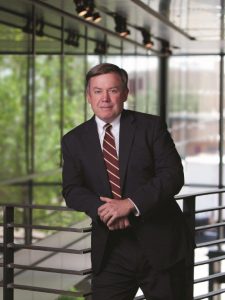Architect of ‘New American University’ to help launch Clemson’s academic year
August 14, 2014CLEMSON, SC – Clemson University will begin the school year by turning the spotlight on a university president who has built a national reputation for making higher education accessible to a broad demographic without sacrificing academic excellence.
Michael Crow, the 16th president of Arizona State University, will speak Aug. 19 at the Victor Hurst Academic Convocation. The ceremony starts at 9 a.m. and will be held at the Brooks Center for the Performing Arts.
American research universities are the finest in the world, Crow said, but they are modeled on the gold standard of the past.
“They define their academic excellence by the qualifications of their incoming students, and their efforts to achieve diversity fall short,” he said. “To achieve a new gold standard takes diversified thinkers unafraid to set the bar above the status quo.”
As ASU president, Crow has been the architect of an alternative model that he calls the “New American University.”
“We measure ourselves not by who we exclude, but rather who we include and how they succeed,” he said.
Clemson University President James P. Clements serves on several national organizations with President Crow and said he has been very impressed by what he has seen in Crow’s transformational leadership.
“As a land-grant institution, Clemson must be transformative and reach those communities that need us the most,” Clements said. “The challenge is going to be, ‘How do we provide access and excellence both at the same time?’
“President Crow, a national leader, has demonstrated how we can do that. We have a responsibility to lift all boats.”
Crow said that when he arrived at ASU in 2002, the university had about 49,000 students.
ASU now has an enrollment of more than 76,000. Graduation of undergraduate students has increased from about 11,000 students in 2003 to nearly 19,000 this year, Crow said.
“At the same time, we’ve improved every measure of graduate success we can get our hands on,” he said. “Our faculty and staff have found a way to enhance quality and growth at the same time.
The university’s research dollars have more than quadrupled from just under $100 million to more than $420 million without a medical school, Crow said.
“The faculty is nearly the same size,” he said. “Everything else is different– structure, design, speed, goals. We have an unbelievable faculty willing to innovate and take on new tasks. Our central objective was to build a university that was needed, rather than try to replicate some university that already existed before us.”
Under Crow’s leadership, ASU has also established more than a dozen new transdisciplinary schools and large-scale research initiatives.
His speech will help open Clemson’s 122nd academic year and is sponsored by Clemson’s College of Engineering and Science.
“President Crow’s vision can serve as a road map as Clemson tackles the grand challenges of the 21st century,” said Anand Gramopadhye, the dean of the College of Engineering and Science.
“His experience has shown us that we must be willing to disrupt the status quo to keep pace with the changing times and have global impact. We should be willing to tear down the walls that separate disciplines and encourage collaboration for the common good.”
Crow was previously executive vice provost of Columbia University, where he also was professor of science and technology policy in the School of International and Public Affairs.
Research universities are at an “evolutionary moment,” he said.
“The normal, slow flow of evolutionary forces we have seen in this sector for about 100 years are no longer sufficiently adaptable to the environmental forces around us,” Crow said. “Some organizations will begin to evolve on a different timeframe and trajectory.
“The future of the American research university will be one that is filled with the emergence of a new class of research university– what I call a super-public.
“They won’t replace older institutions, but will be an emergent new form that are more adaptive to the complexities we’re facing in the broader environment. The new form is excellence and access that is scalable and operates in real time.”


















